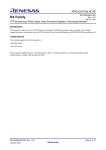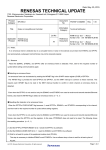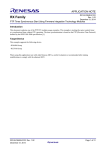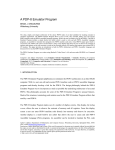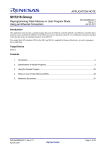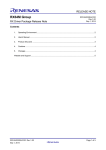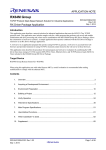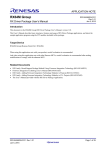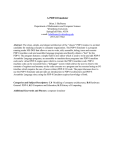Download RX Family Retrieve Recommend Operation of INFABT Occurrence
Transcript
APPLICATION NOTE
RX Family
R01AN2604EJ0100
Rev. 1.00
May 22, 2015
Retrieve Recommend Operation of INFABT Occurrence in The Ethernet Controller
Introduction
This document explains one of the recommend recover operation after when INFABT event was occurred using the
Ethernet and EPTPC Firmware Integration Technology modules. This example also can be used as the reference to
Renesas Technical Update [1].
Target Device
This example supports the following device.
- RX64M Group
- RX71M Group
When using this application note with other Renesas MCUs, careful evaluation is recommended after making
modifications to comply with the alternate MCU.
R01AN2604EJ0100 Rev. 1.00
May 22, 2015
Page 1 of 11
RX Family
Retrieve Recommend Operation in The Ethernet Controller
Contents
1.
Overview ............................................................................................................................................. 3
1.1 Retrieve Recommend Operation of The INFABT Occurrence in The Ethernet Controller .......... 3
1.2 Related documents ...................................................................................................................... 3
1.3 Hardware Structure ...................................................................................................................... 3
1.4 Software Structure ....................................................................................................................... 4
1.5 File Structure ................................................................................................................................ 4
2.
Functional Information ........................................................................................................................ 5
2.1 Hardware Requirements .............................................................................................................. 5
2.2 Hardware Resource Requirements ............................................................................................. 5
2.3 Software Requirements ............................................................................................................... 5
2.4 Limitations .................................................................................................................................... 5
2.5 Supported Toolchains .................................................................................................................. 5
2.6 Header Files ................................................................................................................................. 5
2.7 Integer Types ............................................................................................................................... 5
2.8 Configuration Overview ................................................................................................................ 6
2.9 Data Structures ............................................................................................................................ 6
2.10 Return Values .............................................................................................................................. 6
3.
Specification of This Example ............................................................................................................ 7
3.1 Outline of Functions ..................................................................................................................... 7
3.2 Environment and execution ......................................................................................................... 7
3.3 Recommend Operation ................................................................................................................ 8
3.4 Board Setting ............................................................................................................................. 10
4.
Reference Documents ...................................................................................................................... 11
R01AN2604EJ0100 Rev. 1.00
May 22, 2015
Page 2 of 11
RX Family
Retrieve Recommend Operation in The Ethernet Controller
1. Overview
This document explains one of the recommend recover operation after when INFABT 1 event was occurred using the
Ethernet and EPTPC Firmware Integration Technology (FIT). This example checks the occurrence of the INFABT
event constantly with receiving the frames from other communication devices. When INFABT event was detected, this
example disables the interrupt from the EPTPC, closes the ETHERC and EDMAC, and resets the EPTPC properly.
Thereafter, this example does the initialization process and makes the ETHERC and EDMAC to enable frame transfer
again. The target frame format is only restricted to the Ethernet standard one in this example, though this retrieve
operation also need to be the PTP frame [2]. In detail, please refer to Sec 2.4. Users can implement initialize and
retrieve operations to their own system refer to this example.
1
Time Control Information Abnormality Detection Flag.
1.1
Retrieve Recommend Operation of The INFABT Occurrence in The Ethernet
Controller
This module is implemented in a project and used as the operation example after when INFABT event was occurred.
1.2
Related documents
[1] Notes on Using Ethernet Controller, Rev.1.00, Renesas Technical Update (TN-RX*-A125A/E), May 25, 2015
[2] IEEE Standard for a Precision Clock Synchronization Protocol for Networked Measurement and Control Systems,
Revision of IEEE Std 1588-2008, Mar 2008
[3] RX Family Ethernet Module Using Firmware Integration Technology, Rev.1.02, Document No. R01AN2009EJ0102,
Mar 27, 2015
[4] RX Family EPTPC Module Using Firmware Integration Technology, Rev.1.02, Document No. R01AN1943EJ0102,
Dec 31, 2014
[5] RX Family TCP/IP for Embedded system M3S-T4-Tiny Module Firmware Integration Technology, Rev.2.02,
Document No. R20AN0051EJ0202, Jan 05, 2015
[6] Renesas Starter Kit+ for RX64M, User’s Manual
1.3
Hardware Structure
The Ethernet peripheral modules of the RX64M/71M group are composed of the EPTPC, the PTP Host interface
peripheral module (PTPEDMAC), dual channel Ethernet MAC ones (ETHERC (CH0), ETHERC (CH1)) and dual
channel Ethernet Host interface ones (EDMAC (CH0), EDMAC (CH1)).
In detail, please refer to “RX Family Ethernet Module using Firmware Integration Technology [3]” and “RX Family
EPTPC Module using Firmware Integration Technology [4]”
R01AN2604EJ0100 Rev. 1.00
May 22, 2015
Page 3 of 11
RX Family
1.4
Retrieve Recommend Operation in The Ethernet Controller
Software Structure
This sample is operations example of the application layer. Those operations are to execute the initialization process,
check the INFABT event, receive frames from other nodes, reset hard ware, make frame transfer enable again and so on
using the PTP and Ether driver. The PTP driver always should be used with Ether drivers. TCP/IP middle ware does not
include in this example. Therefore, user needs to implement TCP/IP middle ware (ex.M3S-T4-Tiny the RX Family [5])
when this example applied to the TCP/IP system. Figure 1.1 shows the software structure of this sample.
Sample application
Ether/PTP frame operation
TCP/IP system
This Sample (Retrieve Recommend Operation in The Ethernet Controller)
Application
Initialization process, Check INFABT event, Receive frames from other nodes,
Reset hardware, make frame transfer enable, etc
TCP, UDP/IP (Not use)
PTP UDP/IP (Not use)
Packet (TCP/IP, UDP/IP) trans/receive
Connection manage
Ether Driver(CH0) and Ether Driver(CH1) ctrl
Middle
ware
Ether Driver(CH0) Ether Driver(CH1)
Driver
Frame trans/receive
Node manage
EDMAC(CH0) ctrl
ETHERC(CH0) ctrl
Cable detect
Frame trans/receive
Node manage
EDMAC(CH1) ctrl
ETHERC(CH1) ctrl
Cable detect
EDMAC(CH0)
EDMAC(CH1)
Hardware
PTP UDP/IP
trans/receive
PTP Driver ctrl
PTP Driver
PTP frame
Node manage
Time sync
Event setting
BMC operation
PTPEDMAC ctrl
EPTPC ctrl
PTPEDMAC (Out of scope)
EPTPC
ETHERC(CH0)
ETHERC(CH1)
MII/RMII
MII/RMII
Figure 1.1 Software structure of this sample
1.5
File Structure
This sample codes are stored the “demo_src” and low hierarchical folders. Figure 1.2 shows the source and header file
structure of this sample. The FIT based modules (BSP, Ethernet Driver and PTP Driver), please refer to the
documentation of the each FIT module.
demo_src: sample operation
| sample_main.c
|
+ --- usr: LED control
|
led.c
|
led.h
|
r_bsp: BSP (Board Support Package) FIT module
|
r_ether_rx: Ethernet Driver FIT module
|
r_ptp_rx: PTP Driver FIT module
|
r_config: configuration setting of FIT modules
|
r_bsp_config.h
|
r_bsp_interrupt_config.h
|
r_ether_rx_config.h
|
r_ptp_rx_config.h
Figure 1.2 File structure of this example
R01AN2604EJ0100 Rev. 1.00
May 22, 2015
Page 4 of 11
RX Family
2.
Retrieve Recommend Operation in The Ethernet Controller
Functional Information
This example is developed by the following principles.
2.1
Hardware Requirements
This driver requires your MCU supports the following feature:
EPTPC
ETHERC
EDMAC
2.2
Hardware Resource Requirements
This section details the hardware peripherals that this example requires. Unless explicitly stated, these resources must
be reserved for the following driver, and the user cannot use them.
2.2.1
EPTPC Channel
The example uses the EPTPC (CH0), EPTPC (CH1) or both depend on the kind of Node. Those resources need to the
detection of INFBAT event.
2.2.2
ETHERC Channel
The example uses the ETHEC (CH0), ETHEC (CH1) or both depend on the kind of Node. Those resources need to the
Ethernet MAC operations.
2.2.3
EDMAC Channel
The example uses the EDMAC (CH0), EDMAC (CH1) or both depend on the kind of Node. Those resources need to
the CPU Host interface of standard Ethernet frame operations.
2.3
Software Requirements
This example is dependent upon the following packages (FIT modules):
r_bsp
r_ptp_rx
r_ether_rx
2.4
Limitations
There are following limitations in this example
2.5
Not support PTP format frames
Supported Toolchains
This example is tested and works with the following toolchain:
2.6
Renesas RX Toolchain v2.01.00
Header Files
Each function call is accessed by including a single file, r_ether_rx_if.h, r_ptpif_rx_if.h, r_ptp_rx_if.h or led.h which is
supplied with this project code.
2.7
Integer Types
This project uses ANSI C99. These types are defined in stdint.h.
R01AN2604EJ0100 Rev. 1.00
May 22, 2015
Page 5 of 11
RX Family
2.8
Retrieve Recommend Operation in The Ethernet Controller
Configuration Overview
The configuration options in this example are specified in sample_main.c itself. The option names and setting values are
listed in the table below.
Configuration options
#define NUM_OF_CH
- Default value = 1
#define LINK_CH
- Default value = 1
#define RETRY_TIMES
- Default value = 10000
1
Specify the number of using Ethernet channels.
- Set 1 or 2 in the RX64M/71M.
Specify the PHY access channel of the ETHERC1.
- Set 0: when the PHY access channel is 0.
- Set 1: when the PHY access channel is 1.
Specify the Link up wait times.
This setting should be consistent with the RSK board [6] setting (refer to Sec 3.4) and Ethernet driver configuration.
2.9
Data Structures
This section details the data structures that are used with the functions of this example. Those structures are located in
sample_main.c only as the prototype declarations.
/* MAC addresses assigned in this sample (for test usage) */
const static uint8_t my_mac_addr[2][6] =
{ /* 0: CH0, 1: CH1 */
{0x00,0x01,0x02,0x03,0x04,0x05},
{0x10,0x11,0x12,0x13,0x14,0x15},
};
/* Retrieve times, 0:CH0, 1:CH1 */
int32_t g_CntRet[2] = {0,0};
/* Number of receive frames, 0:CH0, 1:CH1 */
int32_t g_CntRecv[2] = {0,0};
/* Receive frame buffer */
static int8_t R_BUF[4096];
2.10
Return Values
No specific return value exists in this sample.
R01AN2604EJ0100 Rev. 1.00
May 22, 2015
Page 6 of 11
RX Family
Retrieve Recommend Operation in The Ethernet Controller
3. Specification of This Example
3.1
Outline of Functions
The function of this example shows Table 3.1.
Table 3.1 Function of This Example
Item
main()
EINT_Rcv_isr()
INFABT_Reset()
3.2
Contents
Main operation of this example.
Frame reception interrupt handler.
Execute close and reset operation after when INFABT event was
detected.
Environment and execution
This example needs the Renesas Starter Kit+ for RX64M (hereafter RX64M RSK board) [6] or the Renesas Starter Kit+
for RX71M (hereafter RX71M RSK board). The outline of the execution sequence is following.
Connect RX64M/71M RSK board to other devices such as PC, Hub and other communication devices using
Ethernet cables.
Power on the RX64M/71M RSK board.
When the RX64M/71M RSK board finishes the initialization, driver open and link up process, the user LED
composed of LED0, LED1, LED2 and LED3 shows the all-on pattern (LED0: ON, LED1: ON, LED2: ON, LED3:
ON).
The RX64M/71M RSK board waits INFABT interrupt with frame receiving from other devices.
Every when the RX64M/71M RSK board receives a frame from the other devices, the user LED repeats the even
pattern (LED0: ON, LED1: OFF, LED2: ON, LED3: OFF) and the odd pattern (LED0: OFF, LED1: ON, LED2:
OFF, LED3: ON) successively. The counter (=g_CntRecv) of each channel to which indicates the received frame
times is incremented.
When the RX64M/71M RSK board detects INFABT interrupt, this example can detect INFABT interrupt refer to
NFABT detection flag(=is_INFABT) to which the PTP Driver sets the flag of each channel.
This example does the following reset operation.
- Disable interrupt from EPTPC executing the ptp_dev_stop function of the PTP Driver.
- Close EDMAC and ETHERC of the INFABT interrupt occurrence channel.
- In case of using two channel, check whether the INFABT interrupt of another channel was occurred or not.
If it is detected, this sample also close EDMAC and ETHERC of another channel.
- Reset EPTC executing the R_PTP_Reset function of the PTP Driver.
The user LED indicates the INFABT occurrence channel following pattern.
- CH0 pattern: (LED0: ON, LED1: OFF, LED2: OFF, LED3: OFF)
- CH1 pattern: (LED0: OFF, LED1: ON, LED2: OFF, LED3: OFF)
The counter (=g_CntRet) of each channel to which indicates the retrieve times is incremented.
If push the SW1 switch, this example ends after the user LED shows the even pattern (LED0: ON, LED1: OFF,
LED2: ON, LED3: OFF).
R01AN2604EJ0100 Rev. 1.00
May 22, 2015
Page 7 of 11
RX Family
Retrieve Recommend Operation in The Ethernet Controller
Figure 3.1 shows one of the environments during this example.
RX64M/71M RSK board
Port0
Port1
Frame (from PC)
Hub
1
2
3
4
5
Frame (from Communication device)
PC
Communication device
Figure 3.1 Environment
3.3
Recommend Operation
It is recommended to detect INFABT occurrence by interrupt though it occurs only in the singular conditions.
Thereafter, it is need to do the retrieve operation.
Figure 3.2, Figure 3.3 and Figure 3.4 show the recommended software flow overview. Figure 3.2 describes the
operation to enable detection by interrupt and only related to the Ethernet communication. Figure 3.3 describes the
operation executed in the interrupt handler and only related to the INFABT interrupt. In this handler, please execute the
retrieve operation explained by the Figure 3.4 and clear the INFABT flag. Figure 3.4 describes the retrieve operation to
enable communication same as before INFABT occurrence.
Start
1. Initialize Ethernet communication
Set EDMAC0/1 and ETHERC0/1 to enable Ethernet communication
1’. Initialize PTP functionality
Set PTPEDMAC and EPTPC to enable PTP operation1
2. Set ICU EPTPC interrupt enable
ICU.GENAL1.EN0 = 1, Enable interrupt from EPTPC by group AL1 element
3. Set ICU group AL1 interrupt enable
ICU.IPR113 = “EPTPC interrupt request priority”, priority level of INFABT element
ICU.IER0E.EN1 = 1 Permit interrupt request from group AL1
4. Register EPTPC interrupt handler
5. Use
ETHERC02?
No
Yes
EPTPC.MIEIPR.SY1 = 1
EPTPC1.SYIPR.INFABT = 1
EPTPC.MIEIPR.SY0 = 1
EPTPC0.SYIPR.INFABT = 1
6. Enable EPTPC SYNFP0 interrupt
7. Enable EPTPC SYNFP1interrupt
1 No need to set if not using PTP (IEEE1588) functionality
8. Infinite
loop
Wait interrupt from EPTPC
2 Need to enable interrupts from both channel (SYNFP0 and
SYNFP1), if use the two channels.
Figure 3.2 (1) Enable detection by interrupt
R01AN2604EJ0100 Rev. 1.00
May 22, 2015
Page 8 of 11
RX Family
Retrieve Recommend Operation in The Ethernet Controller
Interrupt from EPTPC
Start
Judge interrupt element
Yes
1. From
SYNFP0?
EPTPC.MIESR.SY0 == 1
2. INFABT
element?
No
EPTPC0.SYSR.INFABT == 1
Yes
No
3. Retrieve operation(CH0)
Refer: (3) Retrieve operation
Operation but for INFABT element
4. Clear INFABT flag
EPTPC0.SYSR.INFABT = 1
Judge interrupt element
Yes
5. From
SYNFP1?
EPTPC.MIESR.SY1 == 1
6. INFABT
element?
No
End
EPTPC1.SYSR.INFABT == 1
Yes
No
Operation for the other interrupt
(STCA, PRC-TC, Pulse output timer)
7. Retrieve operation(CH1)
Operation but for INFABT element
8. Clear INFABT flag
Refer: (3) Retrieve operation
EPTPC1.SYSR.INFABT = 1
End
Figure 3.3 (2) Interrupt handler
Start
1. Start EPTPC reset
2. Retrieve
CH0?
EPTPC.PTRSTR.RESET = 1
Yes
No
EDMAC1.EDMAR.SWR =1
4. Reset EDMAC1/ETHERC1
No
EDMAC0.EDMAR.SWR = 1
3. Reset EDMAC0/ETHERC0
5. 64PCLKA passed?
Yes
6. Release EPTPC reset
EPTPC.PTRSTR.RESET = 0
7. Initialize Ethernet communication again
7’. Initialize PTP operation again
End
Set EDMAC0/1 and ETHERC0/1 to enable Ethernet communication again
Set PTPEDMAC and EPTPC to enable PTP operation again1
1 No need to set if not using PTP (IEEE1588) functionality
Figure 3.4 (3) Retrieve operation
R01AN2604EJ0100 Rev. 1.00
May 22, 2015
Page 9 of 11
RX Family
3.4
Retrieve Recommend Operation in The Ethernet Controller
Board Setting
There are two jumpers setting of the RX64M/71M RSK board depending on the PHY access channel of the
configuration option. When the product name of the RX64M/71M RSK board is R0K50564MC001BR or
R0K5RX71MC010BR, Figure 3.5 indicates their changing. And when the product name of the RX71M RSK board is
R0K50571MC000BR, Figure 3.6 indicates their changing depending.
Jumper
J3
J4
LINK_CH = 1 (Default setting)
2-3
2-3
LINK_CH = 0
1-2
1-2
Functional use
ETHERC ET0MDIO or ET1MDIO
ETHERC ET0MDC or ET1MDC
Figure 3.5 Jumper setting
Jumper
J13
J9
LINK_CH = 1 (Default setting)
2-3
2-3
LINK_CH = 0
1-2
1-2
Functional use
ETHERC ET0MDIO or ET1MDIO
ETHERC ET0MDC or ET1MDC
Figure 3.6 Jumper setting
R01AN2604EJ0100 Rev. 1.00
May 22, 2015
Page 10 of 11
RX Family
Retrieve Recommend Operation in The Ethernet Controller
4. Reference Documents
User’s Manual: Hardware
RX64M Group User’s Manual: Hardware Rev.1.00 (R01UH0377EJ)
RX71M Group User’s Manual: Hardware Rev.1.00 (R01UH0493EJ)
The latest version can be downloaded from the Renesas Electronics website.
User’s Manual: Software
RX Family RXv2 Instruction Set Architecture User’s Manual: Hardware Rev.1.00 (R01US0071EJ)
The latest version can be downloaded from the Renesas Electronics website.
Technical Update/Technical News
The latest information can be downloaded from the Renesas Electronics website.
Website and Support
Renesas Electronics website
http://www.renesas.com
Inquiries
http://www.renesas.com/contact/
All trademarks and registered trademarks are the property of their respective owners.
R01AN2604EJ0100 Rev. 1.00
May 22, 2015
Page 11 of 11
REVISION HISTORY
Rev.
Date
1.00
-
May 22, 2015
-
RX Family Application Note
Retrieve Recommend Operation of The INFABT Occurrence in
The Ethernet Controller
Page
—
—
Description
Summary
First edition issued.
All trademarks and registered trademarks are the property of their respective owners.
A-1
General Precautions in the Handling of MPU/MCU Products
The following usage notes are applicable to all MPU/MCU products from Renesas. For detailed usage notes on the
products covered by this document, refer to the relevant sections of the document as well as any technical updates that
have been issued for the products.
1. Handling of Unused Pins
Handle unused pins in accordance with the directions given under Handling of Unused Pins in the
manual.
The input pins of CMOS products are generally in the high-impedance state. In operation with an
unused pin in the open-circuit state, extra electromagnetic noise is induced in the vicinity of LSI, an
associated shoot-through current flows internally, and malfunctions occur due to the false
recognition of the pin state as an input signal become possible. Unused pins should be handled as
described under Handling of Unused Pins in the manual.
2. Processing at Power-on
The state of the product is undefined at the moment when power is supplied.
The states of internal circuits in the LSI are indeterminate and the states of register settings and
pins are undefined at the moment when power is supplied.
In a finished product where the reset signal is applied to the external reset pin, the states of pins
are not guaranteed from the moment when power is supplied until the reset process is completed.
In a similar way, the states of pins in a product that is reset by an on-chip power-on reset function
are not guaranteed from the moment when power is supplied until the power reaches the level at
which resetting has been specified.
3. Prohibition of Access to Reserved Addresses
Access to reserved addresses is prohibited.
The reserved addresses are provided for the possible future expansion of functions. Do not access
these addresses; the correct operation of LSI is not guaranteed if they are accessed.
4. Clock Signals
After applying a reset, only release the reset line after the operating clock signal has become stable.
When switching the clock signal during program execution, wait until the target clock signal has
stabilized.
When the clock signal is generated with an external resonator (or from an external oscillator)
during a reset, ensure that the reset line is only released after full stabilization of the clock signal.
Moreover, when switching to a clock signal produced with an external resonator (or by an external
oscillator) while program execution is in progress, wait until the target clock signal is stable.
5. Differences between Products
Before changing from one product to another, i.e. to a product with a different part number, confirm
that the change will not lead to problems.
The characteristics of an MPU or MCU in the same group but having a different part number may
differ in terms of the internal memory capacity, layout pattern, and other factors, which can affect
the ranges of electrical characteristics, such as characteristic values, operating margins, immunity
to noise, and amount of radiated noise. When changing to a product with a different part number,
implement a system-evaluation test for the given product.
Notice
1.
Descriptions of circuits, software and other related information in this document are provided only to illustrate the operation of semiconductor products and application examples. You are fully responsible for
the incorporation of these circuits, software, and information in the design of your equipment. Renesas Electronics assumes no responsibility for any losses incurred by you or third parties arising from the
use of these circuits, software, or information.
2.
Renesas Electronics has used reasonable care in preparing the information included in this document, but Renesas Electronics does not warrant that such information is error free. Renesas Electronics
3.
Renesas Electronics does not assume any liability for infringement of patents, copyrights, or other intellectual property rights of third parties by or arising from the use of Renesas Electronics products or
assumes no liability whatsoever for any damages incurred by you resulting from errors in or omissions from the information included herein.
technical information described in this document. No license, express, implied or otherwise, is granted hereby under any patents, copyrights or other intellectual property rights of Renesas Electronics or
others.
4.
You should not alter, modify, copy, or otherwise misappropriate any Renesas Electronics product, whether in whole or in part. Renesas Electronics assumes no responsibility for any losses incurred by you or
5.
Renesas Electronics products are classified according to the following two quality grades: "Standard" and "High Quality". The recommended applications for each Renesas Electronics product depends on
third parties arising from such alteration, modification, copy or otherwise misappropriation of Renesas Electronics product.
the product's quality grade, as indicated below.
"Standard": Computers; office equipment; communications equipment; test and measurement equipment; audio and visual equipment; home electronic appliances; machine tools; personal electronic
equipment; and industrial robots etc.
"High Quality": Transportation equipment (automobiles, trains, ships, etc.); traffic control systems; anti-disaster systems; anti-crime systems; and safety equipment etc.
Renesas Electronics products are neither intended nor authorized for use in products or systems that may pose a direct threat to human life or bodily injury (artificial life support devices or systems, surgical
implantations etc.), or may cause serious property damages (nuclear reactor control systems, military equipment etc.). You must check the quality grade of each Renesas Electronics product before using it
in a particular application. You may not use any Renesas Electronics product for any application for which it is not intended. Renesas Electronics shall not be in any way liable for any damages or losses
incurred by you or third parties arising from the use of any Renesas Electronics product for which the product is not intended by Renesas Electronics.
6.
You should use the Renesas Electronics products described in this document within the range specified by Renesas Electronics, especially with respect to the maximum rating, operating supply voltage
range, movement power voltage range, heat radiation characteristics, installation and other product characteristics. Renesas Electronics shall have no liability for malfunctions or damages arising out of the
use of Renesas Electronics products beyond such specified ranges.
7.
Although Renesas Electronics endeavors to improve the quality and reliability of its products, semiconductor products have specific characteristics such as the occurrence of failure at a certain rate and
malfunctions under certain use conditions. Further, Renesas Electronics products are not subject to radiation resistance design. Please be sure to implement safety measures to guard them against the
possibility of physical injury, and injury or damage caused by fire in the event of the failure of a Renesas Electronics product, such as safety design for hardware and software including but not limited to
redundancy, fire control and malfunction prevention, appropriate treatment for aging degradation or any other appropriate measures. Because the evaluation of microcomputer software alone is very difficult,
please evaluate the safety of the final products or systems manufactured by you.
8.
Please contact a Renesas Electronics sales office for details as to environmental matters such as the environmental compatibility of each Renesas Electronics product. Please use Renesas Electronics
products in compliance with all applicable laws and regulations that regulate the inclusion or use of controlled substances, including without limitation, the EU RoHS Directive. Renesas Electronics assumes
no liability for damages or losses occurring as a result of your noncompliance with applicable laws and regulations.
9.
Renesas Electronics products and technology may not be used for or incorporated into any products or systems whose manufacture, use, or sale is prohibited under any applicable domestic or foreign laws or
regulations. You should not use Renesas Electronics products or technology described in this document for any purpose relating to military applications or use by the military, including but not limited to the
development of weapons of mass destruction. When exporting the Renesas Electronics products or technology described in this document, you should comply with the applicable export control laws and
regulations and follow the procedures required by such laws and regulations.
10. It is the responsibility of the buyer or distributor of Renesas Electronics products, who distributes, disposes of, or otherwise places the product with a third party, to notify such third party in advance of the
contents and conditions set forth in this document, Renesas Electronics assumes no responsibility for any losses incurred by you or third parties as a result of unauthorized use of Renesas Electronics
products.
11. This document may not be reproduced or duplicated in any form, in whole or in part, without prior written consent of Renesas Electronics.
12. Please contact a Renesas Electronics sales office if you have any questions regarding the information contained in this document or Renesas Electronics products, or if you have any other inquiries.
(Note 1)
"Renesas Electronics" as used in this document means Renesas Electronics Corporation and also includes its majority-owned subsidiaries.
(Note 2)
"Renesas Electronics product(s)" means any product developed or manufactured by or for Renesas Electronics.
http://www.renesas.com
SALES OFFICES
Refer to "http://www.renesas.com/" for the latest and detailed information.
Renesas Electronics America Inc.
2801 Scott Boulevard Santa Clara, CA 95050-2549, U.S.A.
Tel: +1-408-588-6000, Fax: +1-408-588-6130
Renesas Electronics Canada Limited
9251 Yonge Street, Suite 8309 Richmond Hill, Ontario Canada L4C 9T3
Tel: +1-905-237-2004
Renesas Electronics Europe Limited
Dukes Meadow, Millboard Road, Bourne End, Buckinghamshire, SL8 5FH, U.K
Tel: +44-1628-585-100, Fax: +44-1628-585-900
Renesas Electronics Europe GmbH
Arcadiastrasse 10, 40472 Düsseldorf, Germany
Tel: +49-211-6503-0, Fax: +49-211-6503-1327
Renesas Electronics (China) Co., Ltd.
Room 1709, Quantum Plaza, No.27 ZhiChunLu Haidian District, Beijing 100191, P.R.China
Tel: +86-10-8235-1155, Fax: +86-10-8235-7679
Renesas Electronics (Shanghai) Co., Ltd.
Unit 301, Tower A, Central Towers, 555 Langao Road, Putuo District, Shanghai, P. R. China 200333
Tel: +86-21-2226-0888, Fax: +86-21-2226-0999
Renesas Electronics Hong Kong Limited
Unit 1601-1611, 16/F., Tower 2, Grand Century Place, 193 Prince Edward Road West, Mongkok, Kowloon, Hong Kong
Tel: +852-2265-6688, Fax: +852 2886-9022
Renesas Electronics Taiwan Co., Ltd.
13F, No. 363, Fu Shing North Road, Taipei 10543, Taiwan
Tel: +886-2-8175-9600, Fax: +886 2-8175-9670
Renesas Electronics Singapore Pte. Ltd.
80 Bendemeer Road, Unit #06-02 Hyflux Innovation Centre, Singapore 339949
Tel: +65-6213-0200, Fax: +65-6213-0300
Renesas Electronics Malaysia Sdn.Bhd.
Unit 1207, Block B, Menara Amcorp, Amcorp Trade Centre, No. 18, Jln Persiaran Barat, 46050 Petaling Jaya, Selangor Darul Ehsan, Malaysia
Tel: +60-3-7955-9390, Fax: +60-3-7955-9510
Renesas Electronics India Pvt. Ltd.
No.777C, 100 Feet Road, HALII Stage, Indiranagar, Bangalore, India
Tel: +91-80-67208700, Fax: +91-80-67208777
Renesas Electronics Korea Co., Ltd.
12F., 234 Teheran-ro, Gangnam-Gu, Seoul, 135-080, Korea
Tel: +82-2-558-3737, Fax: +82-2-558-5141
© 2015 Renesas Electronics Corporation. All rights reserved.
Colophon 5.0














